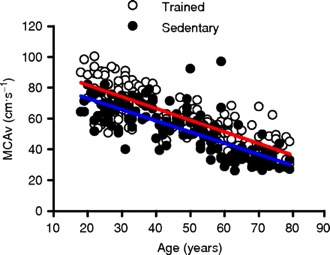Exercise and Brain Size
A few weeks ago I pointed out that age associated cognitive impairment and Alzheimer’s disease shared many risk factors with cardiovascular disease. The brain shrinks as it ages and it shrinks faster in people with cognitive impairment and Alzheimer’s disease. There are also other subtle structural changes associated with aging and cognitive decline. A recent paper in the journal Neurology reported on how physical activity affects brain volume in almost 700 people in their 70s who were studied in England.
“A higher level of physical activity was associated with higher fractional anisotropy (a marker of brain structural integrity), larger gray and normal appearing white matter volumes, less atrophy, and lower white matter lesion load. The physical activity associations with atrophy, gray matter, and white matter lesion remained significant after adjustment for covariates, including age, social class, and health status…..”
Conclusions: In this large, narrow-age sample of adults in their 70s, physical activity was associated with less atrophy and white matter lesion. Its role as a potential neuroprotective factor is supported; however, the direction of causation is unclear from this observational study. “
The paper goes on to discuss factors that might be responsible for the positive effects of physical activity on brain size and function. There is evidence that exercise stimulates the growth of new brain cells and improves connections between brain cells, so no major surprises here.
The paper also mentions that exercise may also improve blood flow to the brain. The figure below is from a study done in my lab by Dr. Jill Barnes. It shows using a measurement called CVCi, that the ability of the brain blood vessels to relax and vasodilate (usually a good thing) in response to CO2 is lower in healthy 60 somethings vs 20 somethings. In both age groups a drug called indomethacin reduced the vasodilation in response to CO2. Blood flow at rest was also lower in the older subjects, or as Dr. Barnes put it:
“Young adults demonstrated greater MCAv (index of blood flow) 55 ± 6 vs. 39 ± 5 cm/s and MCAv reactivity 1.67 ± 0.20 vs. 1.09 ± 0.19 cm·s to hypercapnia (CO2) compared with older adults.”
The next figure I want to show you is from a study on aging and brain blood flow in trained and untrained male subjects.
The authors commented that:
This ∼17% difference between trained and sedentary men amounted to an approximate 10 year reduction in MCAv (blood flow) ‘age’ and was robust to between-group differences in BMI and blood pressure. Regular aerobic-endurance exercise is associated with higher MCAv in men aged 18–79 years.
Summary: Exercise and physical activity do good things for your brain as you age. They help you grow new cells and they keep blood flow to the brain high. One idea is that blood flow is higher because the brain remains bigger in those who are active as they age. The other interesting thing to note is the “10 year” anti-aging effects of exercise on blood flow. That number, or perhaps an even higher one, seems to be pretty consistent for the anti-aging effects of exercise on many elements of our physiology.
This entry was posted on Thursday, November 1st, 2012 at 6:28 am and is filed under Physiology, Research and Health. You can follow any responses to this entry through the RSS 2.0 feed. You can leave a response, or trackback from your own site.




November 17th, 2012 at 2:34 am
Woo Hoo! Dr. Barnes!